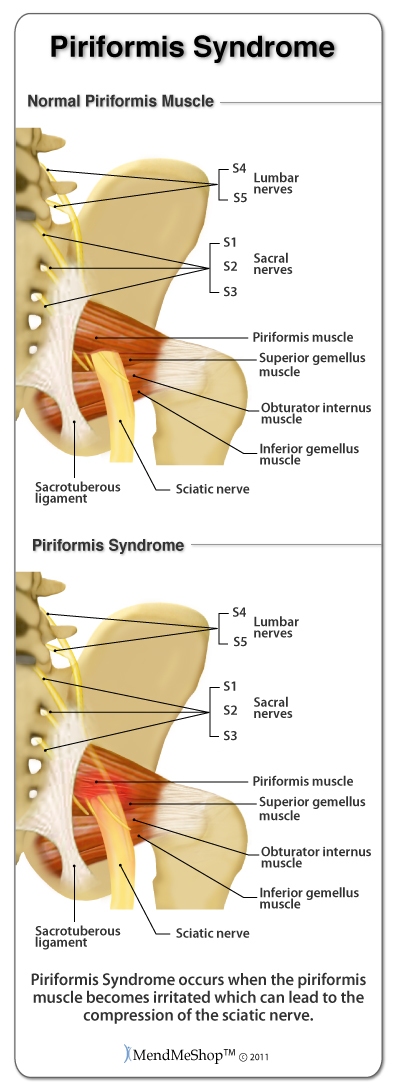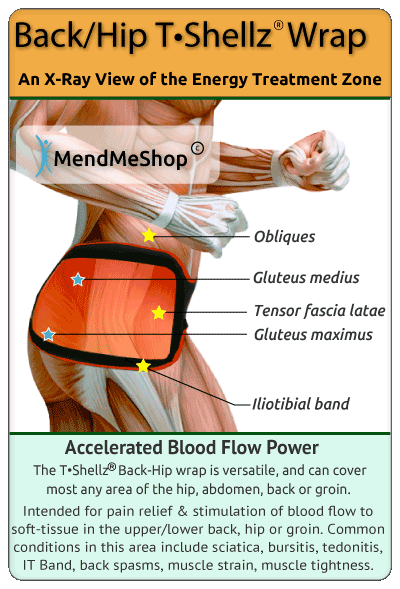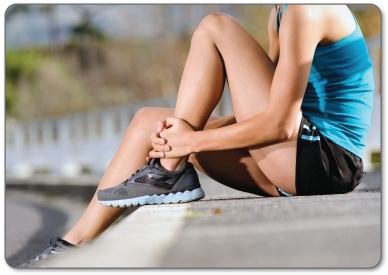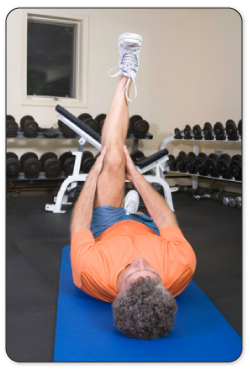Piriformis syndrome is a condition that causes the sciatic nerve to be irritated or compressed by the piriformis muscle. It is a deep muscle in the buttocks that is primarily responsible for rotating the leg outwards. It can irritate the sciatic nerve because of stiffness, tightness, overuse or strain of the piriformis muscle, or as a result of the mechanics or structure of the piriformis area.
In most people, the sciatic nerve passes underneath the piriformis muscle so damage to the piriformis can potentially cause symptoms in the sciatic nerve. A small amount of the population has their sciatic nerve pass through, or split, the piriformis muscle.
The piriformis muscle originates on the anterior surface of the sacrum (tail bone) and sacrotuberous ligament and passes through the greater sciatic foramen. It inserts on the outer side of greater trochanter at the top of leg bone.

Your doctor will do a physical examination and may order an MRI and/or other tests to determine your diagnosis. An MRI will be able to identify if the piriformis muscle is irritated or inflamed and if it is acting on the sciatic nerve.
It is important to rule out that a herniated disc is not causing compression on the sciatic nerve. Your doctor may do some range of motion exercises, or assess your gait (how you walk). Your doctor will determine if certain medications may be appropriate and if physical therapy is required.
Treating the pain of piriformis syndrome can be helpful to manage the pain but treating the source of the compression will result in faster sciatica relief.
Circulation Boost (via a TShellz Wrap®), should be used over your lumbar region and lower back to improve blood flow which in turn will help nourish soft tissue. Your body needs a fresh supply of blood to improve the health of damaged soft tissue. As damaged soft tissue eventually recovers and inflammation is reduced, in most cases this can relieve the compression on your sciatic nerve.

Unfortunately, when you are suffering from piriformis syndrome, it can be painful to even walk or lift your leg. When you limit movement in your hip, the blood flow is reduced - starving your tissue of the necessary oxygen and nutrients.
The trick is to find a way to increase blood flow to your piriformis muscle without causing pain and/or further inflaming the muscle or discs. This is where many of our clients have found the TShellz Wrap® to be quite helpful.
Heat energy generated by the TShellz Wraps® operate by increasing blood flow in our injured soft tissue. This means ligaments, muscles, and tendons. The objective of the TShellz Wrap® is to relax blood vessels - these vessels then gently expand, allowing for more nutrient rich blood flow along with extra oxygen to reach the damaged tissues. Plus, the enhanced blood flow helps in flushing waste and fluid build-up from the injury site - further enhancing the ability of the body to heal.
If you are experiencing referred pain above the knee or in your lower leg caused by the compression of your sciatic nerve, a cold compress can be quite helpful in cases where nerve pressure is caused by inflammation. The cooling sensation along with the compression can help to numb the nerves to help alleviate the pain. However, it is important to treat it at the point where pressure is being put on the nerve, which is not necessarily the same place as where the pain is noticed. The term for an injury indicating pain elsewhere in the body is termed as "referred pain", and is somewhat common when dealing with nerve-based pain.
Cold compression works best to relieve pain, swelling and inflammation for new injuries, re-injury and during immediate post surgery recovery. Cold therapy should also be used during the first 24 - 72 hours of treatment, combined with resting your injury.
If you've been suffering for some time with a chronic hip cuff injury you should only use cold after activity causes you more pain or triggers more inflammatory response symptoms (red, hot, inflamed, swollen).. This would be when your hip, outer thigh or lower back starts to hurt at the end of the day after you've been on your feet throughout the day. When used at this time cold compression becomes a natural / organic pain reliever, targeting the localized site where you feel the pain.
Sometimes we feel pain while doing a certain activity - should you still use cold? Too much cold therapy can reduce your ability to heal correctly, because cold is a short term pain reliever, not a deep tissue healer.
Cold Compression slows nerve and cell function - reducing swelling that blocks blood vessels from doing their job.
This is important because once blood vessels are blocked or damaged, they can no longer carry oxygenated blood through the tissue, so cells begin to break-down. Without cold therapy, tissue damage and break-down continue as they cannot get the oxygen they need to survive. By limiting the amount of damage done to your hip, you also limit the amount of healing that needs to occur. This is an important step to heal muscle or tendon injuries faster and with less pain!

HEAT (warmth) is used after you've reduced your swelling / inflammation and the sharp pain is less intense (you have more of a dull / nagging ache and soft tissue tightness in your hip). Increasing the temperature in soft tissue will result in increased blood flow circulation as the body sends more blood there to attempt to remove this same heat. It's the blood in your body that will bring oxygen, nutrients and water (basically energy) to your injured hip to help with healing.
When heat is applied to the hip, veins and blood vessels will start to get bigger (expand) to allow more blood flow through to your damaged or torn soft tissue. This in turn relaxes your hip, making the tissue more flexible and elastic. This is why heat is used on older (chronic) injuries, to loosen tissue and bring in the blood flow needed for soft tissue to repair. Your body will begin to heal itself after it is injured - increasing your blood flow with heat will, in most cases, speed up this natural process - often surprisingly well.
Doctors usually call this process 'Vasodilation'.
Heat can Make Inflammation, Swelling and Newer Injuries Worse - How?
When we injure ourselves, we start healing right away. The body will naturally raise the temperature at the site of the injury resulting in the inflammatory response (redness, heat sensation, inflammation and swelling). This 'fake fever' leaks blood flow to the area to cool it down and start the healing process.
Adding 'heat' to your hip when it's already inflamed and tender may make your body think there's a new threat to your tissue and increase the pain in order to get you to stop. For some people applying heat on inflamed / swollen tissue will cause the injury to swell-up even more (as much as 3 times larger than normal). You'll feel even more pain as the pressure builds in your hip.
Heat is NOT a good treatment method for inflamed soft tissue, new injuries (within the first 24 to 72 hours), right after surgery or right after a re-injury (over-use and/or sharp, throbbing pain). In these cases, heat should be applied later on in the healing cycle. In the meantime, use a Cold Compress or Ice Pack to decrease any inflammation induced pain.
The primary intent of a heat based application is to increase blood flow circulation and, as such, stimulate the body's own natural recovery process for older (chronic) or recent (acute) injuries, long-term post surgery recovery and more recently - for some regenerative therapies performed by doctors and pts. Warmer temperatures should be used approximately 3 to 5 days after you first have the injury or even later if the swelling has not reduced significantly. Heat should not be started for a least 2 weeks after surgery because inflammation levels will be very high as the healing process starts over again. Any use of heat should also be combined with gradual movement to stretch out your hip and increase range of motion.
If you have a chronic hip injury that keeps getting re-injured you should use heat before activity to loosen up your tissue (making it more flexible). When used at this time the warm temperatures naturally extend the elasticity (elastic-nature) of the joint, making it more movable / pliable for activity.
Sometimes we feel pain while doing a certain activity - should you still use heat? Using heat in the morning before you start your day or before activity can help to boost flexibility and overall health in soft tissue, helping reduce your risk of re-injury. Too much heat (especially when you suffer a set-back with swelling / inflammation) can make your inflammation worse. Cold treatments with a Cold Compress or Ice Pack should be used part-way through your day when you suffer from on-going pain and inflammation as a natural pain-reliever.
Using heat is a good long-term plan because it can be used on a preventive basis to relax constricted soft tissue. Heat will increase the volume of blood circulation, which in turn, brings all the components your body needs to heal more efficiently - oxygen, nutrients, anti-bodies and energy.
Click HERE to Go To Our Online Store We take all major credit cards and Paypal.
If you have questions, call our office at 1-866-237-9608 (toll free continental US).
We are currently offering FREE SHIPPING and a 60 day trial period on all our Wraps.

For many people, the treatment won't just end there. Stretching is also an important part of of deep hip healing - and it's the final step needed when healing your injury with conservative treatment methods.
You would be surprised by how many people there are that don't understand the importance of stretching. Before returning to full activity after a hip injury, physical therapists prescribe gentle stretching of the affected area... This is because stretching an important part in recovery from any soft tissue injury. Consistent stretching is one of few solutions available to break up scar tissue that forms on your hip as it heals.
Warming up soft tissue via the use of a Back/Hip TShellz Wrap® before stretching (or any significant activity that involves the hip) is, in our opinion, a simple way to help minimize the risk of re-injury (or worsening the existing injury)
We're going to let you in on a key piece of information... In every physical therapy appointment your physical therapist will use conservative treatments, massage, manual manipulation and/or stretching exercises to give you this Professional 3-Step Treatment Formula:
For this 1st step many physical therapists will use heat, manual manipulation, deep tissue massage, clinical ultrasound devices or a warm bath to warm up your hip. The goal during this first step is to increase healthy blood flow circulation and relax your affected hip.
'Warming up' your hip will increase the elastic-nature of your hip fibers making it much easier to stretch and when needed, hold the stretch. This will also extend the amount that you will be able to stretch your hip.
Use a TShellz Wrap® for 15 to 20 minutes at least half an hour before stretching your hip. A TShellz® Circulatory Boost Wrap is a therapy intended to increase the blood flow to the hip while warming up and relaxing your injured tissue. Circulatory Boost will help soft tissue in the area more elastic and pliable, allowing for more ease of movement when you're stretching and/or exercising.

The main goal of physical therapy is to exercise (stretch out) the affected hip to improve flexibility and range of motion. After the physical therapist has warmed up your hip, they'll get you to do a series of exercises that are focused on stretching out your hip.
This exercise may include heel slides that are focused on moving your how leg and hip (quadriceps, groin, hip, hamstring, calf and shin).
Sometimes cardiovascular exercise, like using a stationary bike or treadmill, will be recommended under the supervision of your physical therapist.
Why are hip injuries so hard to over come? In two words - scar tissue.
Soft tissue in the hip is meant to be tough yet flexible, ready to work and move extreme forces in everyday activities. Damaged tissues heal with scar tissue; little tiny band-aids that overlap each other on the tissue mending the injury. With added scar tissue your hip becomes rigid, less able to receive the full force of your movements. If you're suffering with scar tissue now, you may feel the effects with stiffness, tightness, weakness and tiredness in your hip.
Scar tissue can form fast to bring together the edges of a tendon, ligament of the tissue tear, but working fast doesn't mean that the job's done right. When scar tissue forms it doesn't come together as neatly as regular (healthy) tissue would. Scar tissue fibers will lay down over top of your tear in a cluttered, messy and jumbled up way.
Stretching helps to break up scar tissue, ultimately reducing its troublesome effects on your body.
Toward the end of your appointment your physical therapist may introduce cold compression, acupuncture, or TENS to relax your hip after the intense stretching and exercise.
It may seem hard to believe, but our TShellz Wraps®, ebooks and accessory products will assist many of you in recovering from your injury by reducing your swelling and inflammation induced pain, maximizing localized blood flow, and increasing the flexibility / range of motion in the hip. We strongly believe that we can help you, and we have thousands of happy clients to back this claim. You are welcome to try our products for a 60 day period.. However, we also know our products will not work for everyone, so in such cases: if you are committed to following the treatments outlined in the product instructions and you do not receive the benefits that countless of our other customers have experienced from our products, call us for instructions to mail the product back so we can provide you with a full product refund.
Here at MendMyHip we pride ourselves in helping you with your healing and recovery process. Everyone at MendMyHip has tested and used the products, finding solutions to conditions that do not fit into the norm. This dedication to our customers and our products goes hand-in-hand with our guarantees to you as a customer:
Click HERE to Go To Our Online Store We take all major credit cards and Paypal.
If you have questions, call our office at 1-866-237-9608 (toll free continental US).
We are currently offering FREE SHIPPING and a 60 day trial period on all our Wraps.
Product Advisors are available 9:00 am to 5:00 pm Eastern Standard Time Monday to Friday.
I want to learn more about Hip Surgery & Post-Surgery Recovery
I want to learn more about Circulation Boost
I want to learn more about Ice & Heat: Which Is Better For The Hip?
I want to learn more about Trigger Points in the Hip
I want to learn more about Hip Surgery: Do I Need It?
During your recovery, you will probably have to modify and/or eliminate any activities that cause pain or discomfort at the location of your soft tissue injury until the pain and inflammation settle. The more diligent you are with your treatment and rehabilitation, the faster you will see successful results!
Please be aware that this information is neither intended nor implied to be a substitute for professional medical advice. CALL YOUR HEALTHCARE PROVIDER IMMEDIATELY IF YOU THINK YOU MAY HAVE A MEDICAL EMERGENCY. Always seek the advice of your physician or other qualified health provider before using any of our outstanding products to make sure they are right for you and your condition or if you have any questions regarding a medical condition. Always see your doctor for a proper diagnosis as there are often many injuries and conditions (some very serious) that could be the cause of your pain.
© 2025 In.Genu Design Group, Inc. Contact Us